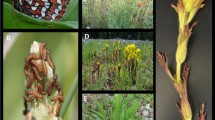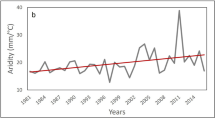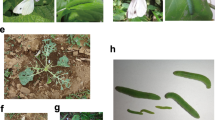Summary
Two Colorado populations of Pieris butterflies show a spectrum of larval growth responses to potential foodplant crucifer species growing in montane habitats. Analysis of larval growth responses to this array suggests potential selection for differential utilization of these species: 1) available crucifers vary considerably in the rates of larval survival and growth they support; 2) climatological factors favor larvae which develop rapidly. Food-related larval mortality and climatological factors may provide selection for utilization of crucifer species on which larvae develop rapidly.
Similar content being viewed by others
References
Brues, C. T.: The specificity of foodplants in the evolution of phytophagous insects. Amer. Nature. 58, 127–144 (1924)
Burnett, W. C. Jr., Jones, S. B. Jr., Mabry, T., Padolina, W. G.: Sesquiterpene lactonesinsect feeding deterrents in Vernonia. Biochem. Syst. Ecol. 2, 25–29, (1974)
Chew, F. S.: Strategies of foodplant exploitation in a complex of oligophagous butterflies (Lepidoptera). Ph.D. dissertation, New Haven, Yale University (1974)
David, W. A. L., Gardiner, B. O.: Mustard oil glucosides as feeding stimulants for Pieris brassicae in a semi-synthetic diet. Entomol. Exp. Appl. 9, 247–255 (1966)
Dethier, V. G.: Evolution of feeding preferences in phytophagous insects. Evolution 8, 33–54 (1954)
Ehrlich, P. R., Breedlove, D., Brussard, P., Sharp, M.: Weather and the “regulation” of subalpine populations. Ecology 53, 243–247 (1972)
Ehrlich, P. R., Raven, P. H.: Butterflies and plants: a study in coevolution. Evolution 18, 586–608 (1964)
Engelmann, F.: The physiology of insect reproduction. New York: Pergamon 1970
Fraenkel, G. S.: The raison d'etre of secondary plant substances. Science (Wash. D. C.) 129, 1466–1470 (1959)
Gibbs, R. D.: Chemotaxonomy of flowering plants. Montreal: McGill-Queens University 1974
Hegnauer, R.: Chemotaxonomie der Pflanzen. Basel: Birkhauser 1962–1969
Joseffson, E.: Studies of the biochemical background to differences in glucosinolate content in Brassica napus L. II. Administration of some sulfur-35 and carbon-14 compounds and localization of metabolic blocks. Physiol. Plant. 24, 161–175 (1971)
King, C. E.: Resource specialization and equilibrium population size in patchy environments. Proc. nat. Acad. Sci. (Wash.) 68, 2634–2637 (1971)
Labine, P. A.: The reproductive biology of the checkerspot butterfly, Euphydryas editha. Ph.D. dissertation, Stanford, Stanford University (1966)
Langenheim, J. H.: Vegetation and environmental patterns in the Crested Butte area, Gunnison County, Colorado. Ecol. Monog. 32, 249–285 (1962)
Marquand, R., Kuhn, H., Linser, H.: Der Einfluß der Schwefelernährung auf die Snefolbildung. Z. Pflanzenernähr. Bodenk. 121, 221–230 (1968)
Remington, C. L.: The biology of Nearctic Lepidoptera. I. Foodplants and life histories of Colorado Papilionidae. Psyche 59, 61–69 (1952)
Rochow, T. F.: Ecological investigations of Thlaspi alpestre L. along an elevational gradient in the central Rocky Mountains. Ecology 51, 649–656 (1970)
Scheffé, H.: A method for judging all contrasts in the analysis of variance. Biometrika 40, 87–104 (1953)
Schoonhoven, L. M.: Chemoreception of mustard oil glucosides in larvae of Pieris brassicae. Proc. roy. Acad. Sci. Amsterdam 70C, 556–568 (1967)
Sherman, P. W., Watt, W. B.: The thermal ecology of some Colias butterfly larvae. J. comp. Physiol. 83, 25–40 (1973)
Skytt-Andersen, A., Muir, R. M.: Auxin activity of glucobrassicin. Physiol. Plant. 19, 1038–1048 (1966)
Snedecor, G. W., Cochran, W. G.: Statistical methods, 6th ed. Ames: Iowa State University 1966
Thorsteinson, A. J.: Host selection in phytophagous insects. Annu. Rev. Entomol. 5, 193–218 (1960)
United States Dept. Commerce.: Climatological data, Colorado. Washington: U.S. Government Printing Office 1949–1974
Verschaffelt, E.: The cause determining the selection of food in some herbivorous insects. Proc. Sci. kon. Akad. Wet. Amsterdam 13, 536–542 (1910)
Author information
Authors and Affiliations
Rights and permissions
About this article
Cite this article
Chew, F.S. Coevolution of pierid butterflies and their cruciferous foodplants. Oecologia 20, 117–127 (1975). https://doi.org/10.1007/BF00369024
Received:
Issue Date:
DOI: https://doi.org/10.1007/BF00369024




